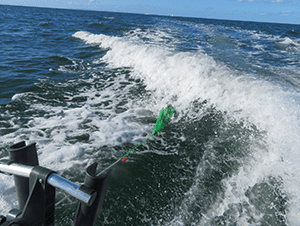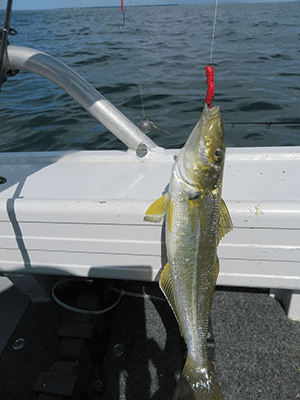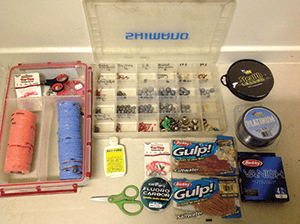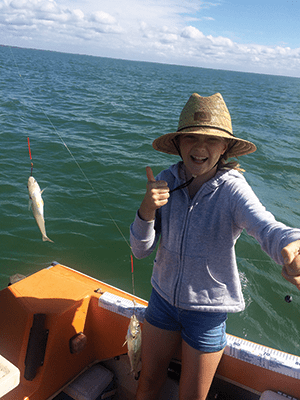IT’S that time of year and yes, the winter whiting, or ‘winteries’ as they are affectionately known, are on the chew.
Fish have been schooling in all the usual places around Moreton Bay and other popular locations such as the Great Sandy Strait near Hervey Bay. Their numbers have been picking up through April and May and will only improve during winter. Winter whiting are a great option for a family fun day of fishing in the boat or for some mates who want to share a few laughs while catching fish.
While catching winteries is not rocket science, several tips and techniques can put you onto fish a bit quicker and make things easier.
Distinguishing features
Readers should be aware that summer whiting can be mixed in with the schools of winteries, so you need to be able to distinguish between them. Winter whiting (also known as diver whiting) can be distinguished from summer whiting by a number of key characteristics. Winter whiting have dark blotches or spots along their back and sides and they have a paler belly with a silver horizontal band.
Summer whiting are a uniform silver colour and have pale yellowish pectoral, pelvic and anal fins. While there is no minimum size for winter whiting (summer whiting is 23cm), any fish under 21-22cm is hardly worth the trouble of filleting. In Queensland, the current bag limits are 50 winter whiting and 30 summer whiting. While they are commonly captured around 25cm, I find the bigger fish of 28-30cm are generally caught on soft plastic worms.
Areas to find them
Winter whiting prefer a mix of silty and muddy bottoms. The places to start in Moreton Bay are on the banks such as Chain, Maroom, Banana, Pelican and Amity (outside the green zone), as well as around the edges of the Rous Channel, the Blue Hole, Fishermans Gutter and the Moreton Island Sandhills.
Winter whiting used to be in good numbers out from Wynnum but catches have thinned out in recent years. Further north at Hervey Bay, my brother-in-law has been getting amongst them out from Tuan and you can generally find them from just south of Maaroom in the north to east of Tinnanbar in the south.
After arriving at a chosen location, I like to use my sounder to look for clear patches of sand between ribbon weed if I can’t find any schools by searching in a grid pattern using my Lowrance StructureScan (side scan) technology. Winteries also tend to be found in deeper water than summer whiting, with my hot spots being areas in 3-4.5m of water.



Set your long, whippy rods low to the water and the fish will hook themselves.

They can certainly be found in even deeper water, such as near the Moreton Island Sandhills. Furthermore, during most winters some of the smaller fish (under 25cm) also enter the mouths of rivers and creeks. Interestingly, the fish occasionally disappear when the water gets deeper than 3.5m while drifting, and other days they start appearing at 3.5m and increase in numbers as the water gets deeper.
I’ve found a bit of a pattern in that if the water is very clear, they will move to deeper water (3.5m-plus). Another tip is to use your GPS like a fishing diary. You can apply the same principles as I do for mud crabs and any species of fish. Mark locations where you catch a number of fish and then rename the centre mark with the species and date.
Such as: ‘Winter whiting June17’. This way, you can search your waypoints for the species you are after and find a location from either a recent month or the same month from a previous year.
Failing all that, if you can’t find any fish and don’t mind crowds, you can play spot the boats and join in. But please give people room and don’t anchor within casting range of somebody else or anchor when others are drifting the area.
Drift or anchor?
As a general rule, I find that if the water is glassy, the fish get a bit wary and prefer a moving bait, so I drift or cast and retrieve at anchor. In water under 4m with glassy conditions, I find you need to cast further away from the anchored boat. If you find what looks to be a nice school of whiting, anchor up-current from them and cast your baits back to the school.
Otherwise, if the fish are more spread out I will drift until I land a couple of quick fish in succession and then GPS mark that spot. If you don’t have a GPS, you can drop a coloured float over with a brick tied to the bottom and continue to drift. If the fish are widespread, I might continue to drift further along until they go quiet before returning to the top of my drift.
I always drive around in a wide arc so as not to spook the fish by driving over the top of them. When at anchor, I also try to concentrate the fish in the area by dropping over a berley bucket full of chicken pellets covered in a couple of capfuls of tuna oil. I make sure the bucket is weighted so it sits on the bottom and the current doesn’t carry the berley away.
I also give the rope on the berley bucket a couple of pulls every five minutes to keep up the trail. Sometimes when I anchor the fish go quiet for a while. Give it 10 minutes, and if no fish, try a slow retrieve with one rod and if you get a hit this can show that the fish prefer a moving bait. You can then either keep up that technique or pull anchor and drift again.
Baits and lures
Believe it or not, small worm lures put straight onto your hook like a bait are incredibly productive in all but glassy conditions. My favourite lures are the 2” Berkley Gulp Sandworms in Bloody colour. They have little feelers on them that make them look lifelike and when moving they bring the lure to life.
My number-one bait is worms, especially red-dyed frozen worms if you can get them, with yabbies a close second. While live bloodworms are fantastic baits for winter whiting, they are expensive to buy and hard work to dig. I know a few people who swear by thin squid strips covered with red dye to look like worms. Likewise, peeled prawns will also catch you fish, though they never seem to be as good as worms for me.
Rods, rigs and tackle
As with all my whiting fishing from a boat, I prefer 7’-9’ whippy rods coupled with either a small Alvey or 1000-2000-size spinning reel. The longer, soft whippy rods enable the whiting to grab the bait and swallow it without feeling too much resistance. I like to let the rod load up with the weight of the fish before lifting and winding the reel in one action to set the hook.
If you are using an Alvey, you can wind backwards on the reel to give the fish line and then wait for it to swallow the bait and run, which will load up your rod. I like to run 6lb mono on my reels because it is strong enough to lift a couple of whiting into the boat. I also like to use clear fluorocarbon traces of 6lb breaking strain.
My favourite rig for winter whiting is a double-dropper paternoster rig. I attach a 1-1.2m trace of fluorocarbon to a small size 10 swivel and then tie two tagless dropper loops of about 15-20cm attached to a fixed sinker on the bottom. I also make a few spare rigs and wrap them around a small piece of pool noodle.
Depending on the size of my bait, I like to run small long-shank hooks in size 4 or 6. I tend to use size 4 for yabbies and 6 for worms. I particularly love Tru-Turn hooks. Another little trick is to add two or three 1cm-long pieces of red tubing or a couple of red beads on top of your hooks for added attraction.
Finally, as with most fishing, make sure you aren’t handling your baits and lures with hands that smell of sunscreen, fuel, oil and so on.
If they do, rub a little bit of bait scent on your fingers and then wipe them dry with a rag before touching your rod. If the action is quiet, such as around the change of tide, I will also add scent to my baits, which tends to improve results.
Scaler bag
Finally, when it comes to the end of the session and you have quite a few fish to fillet, there is a much easier way than scaling or skinning the fish.
First, I ensure my fish are nice and firm by keeping them in an ice slurry in my trusty Ice Box Bloke Esky with a 1:1 ratio of ice and salt water. Then at the end of the session when the fish are firmed up, they go in a scaler bag (available at most tackle shops).
To it I tie 2-3m of rope and secure it to the stern of the boat. I then motor off at sufficient speed for the bag to spin on the surface in the wash for two or three minutes, which effectively scales the fish. If you prefer your fillets skinless, it is best to leave the scales on for removing the skin.
I hope you too get a nice feed of winteries this winter!
For more winter tips in Moreton Bay, click here!
For more tips, reports and giveaways, check out my Facebook page at facebook.com.au/OntourFishingAustralia
Until next time – bag your mates, not your limit!
 Bush 'n Beach Fishing Magazine Location reports & tips for fishing, boating, camping, kayaking, 4WDing in Queensland and Northern NSW
Bush 'n Beach Fishing Magazine Location reports & tips for fishing, boating, camping, kayaking, 4WDing in Queensland and Northern NSW








